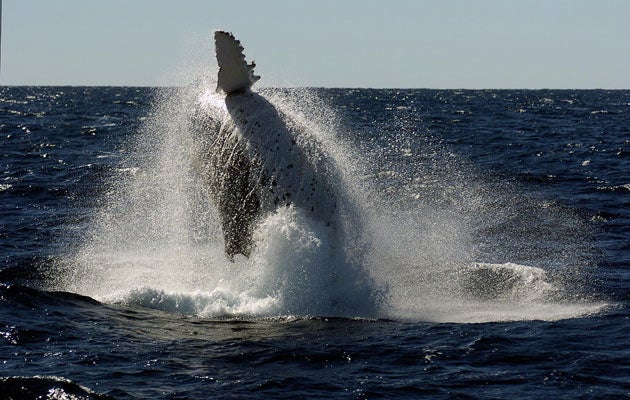Swimming with humpbacks: the journey of life
A hunting ban has restored numbers of the humpback whale but scientists warn one-fifth of all mammals could soon die out.

Your support helps us to tell the story
From reproductive rights to climate change to Big Tech, The Independent is on the ground when the story is developing. Whether it's investigating the financials of Elon Musk's pro-Trump PAC or producing our latest documentary, 'The A Word', which shines a light on the American women fighting for reproductive rights, we know how important it is to parse out the facts from the messaging.
At such a critical moment in US history, we need reporters on the ground. Your donation allows us to keep sending journalists to speak to both sides of the story.
The Independent is trusted by Americans across the entire political spectrum. And unlike many other quality news outlets, we choose not to lock Americans out of our reporting and analysis with paywalls. We believe quality journalism should be available to everyone, paid for by those who can afford it.
Your support makes all the difference.In the aquamarine waters off the paradise atolls of French Polynesia a diver comes face to face with one of the world's most impressive creatures: a female humpback whale accompanied by her young calf. These images, captured by the French underwater photographer Yves Lefèvre, show how the two whales happily "dance" with their new friend before continuing on one of the world's most remarkable migrations.
"This is one of my favourite pictures," said Lefevre, 46, who took the photographs during a two-hour dive off the island of Rurutu, in the archipelago of the Austral Islands.
"Here you see my good friend and diving expert Eric Leborgne swimming so close to this beautiful humpback whale. Eric and I were diving for more than two hours with this whale which had only one idea – play with us. As the whale became more relaxed with us being close to her, I managed to take this picture."
Every year, humpback whales travel more than 15,000 miles across the world's oceans in search of krill that, despite their tiny size, are the main source of food for some of the ocean's largest creatures. The warm waters around Rurutu are one of the few locations that the southern population of humpbacks is known to give birth, making it an ideal place to film and photograph calves interacting with their mothers.
However, most people who are lucky enough to catch a glimpse of these whales are introduced to the humpback in a much less tranquil way. Watching 79,000lbs of cetacean breaching the ocean surface before crashing back down into the depths below is one of the ocean's most breathtaking taking sights.
The hunched shape their back makes as they dive led to their popular moniker while the scientific community refers to them as Megaptera novaeangliae because they were first observed scientifically off the coast of New England, in the US.
While many mammals teeter towards oblivion – a report by the International Union of the Conservation of Nature released yesterday says that one in five mammals are now at risk of extinction – humpbacks are making a comeback because of a global moratorium on commercial whale hunting.
By the time the ban was introduced in 1966, the global humpback population was thought to have declined by 90 per cent in as little as 50 years of industrialised whaling. There are thought to be about 80,000 humpbacks alive now and even Japan, which, despite international outrage, has resumed whaling in the Arctic, has said that it will leave humpbacks alone.
Its fellow cetaceans are not so fortunate. Nearly a quarter of whale and dolphin species are threatened and, of those, more than 10 per cent (nine species) are listed as "endangered" or "critically endangered", the highest categories of threat.
The Yangtze river dolphin is thought to be the most recent cetacean species to have died out and the IUCN predicts that the vaquita (Phocoena sinus), a porpoise in the Gulf of California, Mexico, is likely to be the next to become extinct in the wild, where only 150 adults are left.
The IUCN describes itself as the world's oldest and largest global environmental network and is comprised of more than 11,000 volunteer scientists across 160 countries.
Its latest Red List of Endangered Species, released yesterday, estimates that up to one in five mammal species, 1,141 out of 5,487, are threatened with extinction.
"Within our lifetime hundreds of species could be lost as a result of our own actions, a frightening sign of what is happening to the ecosystems where they live," added Julia Marton-Lefèvre, the IUCN's director general. "We must now set clear targets for the future to reverse this trend to ensure that our enduring legacy is not to wipe out many of our closest relatives."
Join our commenting forum
Join thought-provoking conversations, follow other Independent readers and see their replies
Comments